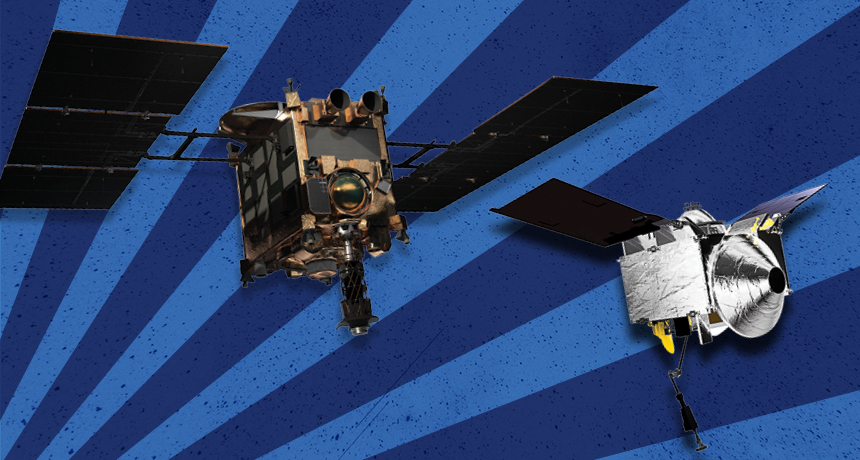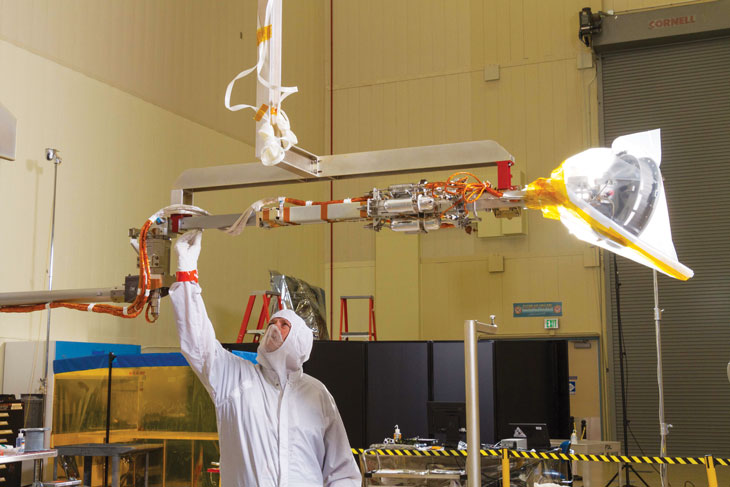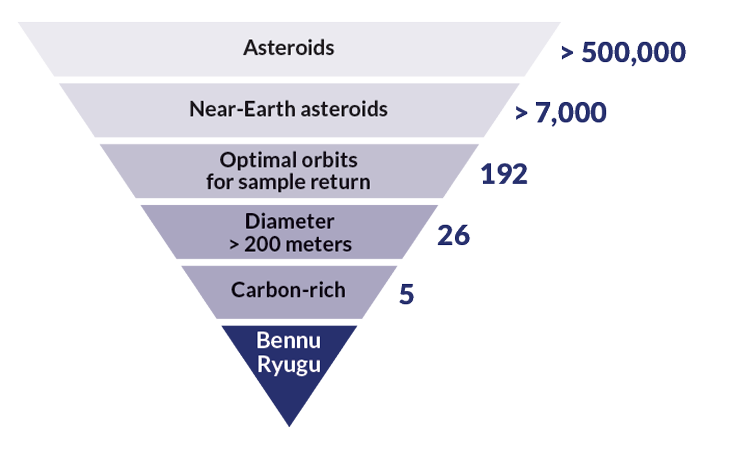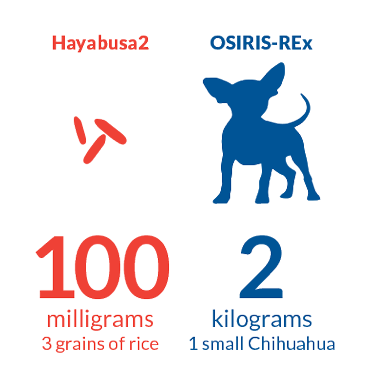Two daring spacecraft aim to bring asteroid dust back to Earth
The pristine space material may help explain life’s beginnings

TREASURE HUNTERS Two spacecraft, Hayabusa2 (left) and OSIRIS-REx (right), began exploring two ancient asteroids in 2018. Both craft are expected to pick up samples of their respective rocks and carry them to Earth.
Hayabusa2: DLR (CC BY 3.0); OSIRIS-REx: Conceptual Image Lab/NASA’s Goddard Space Flight Center
Shogo Tachibana greeted asteroid Ryugu with dread.
The cosmochemist with the University of Tokyo had spent 10 years helping to design a mission to Ryugu’s surface. To touch down safely, the spacecraft, Hayabusa2, needs to find broad, flat stretches of fine-grained dust on the asteroid. But on June 27, when Hayabusa2 finally reached its target after a three-and-a-half-year journey (SN Online: 6/27/18), Tachibana got a rude awakening: Ryugu is covered in boulders. Big ones.
“We cannot find a 100 percent safe place to touch down,” Tachibana says. “It seems to be a very dangerous place.”
If Hayabusa2 can deal with the boulders — and any other challenges that arise — it will become only the second spacecraft to bring a piece of an asteroid back to Earth. And the mission will answer questions that its predecessor couldn’t. The original Hayabusa mission visited a sand- and rock-covered asteroid called Itokawa in 2005. But Itokawa has the wrong chemical makeup to address big questions about the origin of life that Ryugu, which is carbon-rich, is well suited for. And Hayabusa suffered a series of calamities that caused it to return to Earth several years late, with less than 2,000 grains of precious asteroid dust.
Tachibana and colleagues from the Japanese Aerospace Exploration Agency, or JAXA, are counting on Haybusa2 to return bits of Ryugu’s surface to Earth in 2020. And if a daring plan to blow a crater into the asteroid works, the spacecraft will get some subsurface grains as well.
A sister project from NASA, the OSIRIS-REx mission, arrived at an asteroid called Bennu in December to bring samples back in 2023 (SN Online: 12/3/18).
The two spacecraft face daunting challenges. The probes must investigate objects that have so little gravity that sunlight can knock them off their orbits. If the probes manage to pick up samples, the spacecraft must keep the dust pristine during the trip back to Earth. To get the most out of the missions, the Japanese and American teams are trying to work together across cultural and bureaucratic divides.
But the uncertainties and anxiety are worth it. Asteroids like Ryugu and Bennu are among the oldest and most intriguing objects in the solar system. They could hold the keys to some of the most pressing planetary questions: What came before the planets? What are the origins of life? And how much of a threat do asteroids pose to life on Earth today?
Of course, planetary scientists already have tens of thousands of asteroid pieces to study. Such meteorites fall to Earth in the hundreds each year, offering researchers plenty of material to slice, grind and examine for clues to the solar system’s history.
Dante Lauretta of the University of Arizona in Tucson, the principal investigator of OSIRIS-REx, spent the first part of his career trying to coax meteorites into telling him whether molecules necessary for life — such as nucleic acids, amino acids and phosphorus, which are structural components of DNA — could have originated inside carbon-rich asteroids like Ryugu or Bennu.
Carbon-rich asteroids are thought to be mostly unchanged since their formation at least 4.6 billion years ago, which makes them perfect time capsules. A few grains of such an asteroid could reveal what the early solar system was made of.
Remote studies of asteroids also suggest that the raw ingredients for life, and maybe even the chemical processes that are necessary for life to begin, might have been present on carbon-rich asteroids even before the planets were done growing.
“We think an asteroid like this one may have delivered this material to the surface of the early Earth, providing seeds or building blocks of life,” Lauretta says. “If we can show the precursors [of life] started before the planet, I think the probability that there’s life elsewhere in the solar system goes way up.”
Studying meteorites to explore this notion falls short on two fronts, however: It’s hard to tell where they come from, and they’re contaminated. As soon as a space rock hits Earth’s atmosphere, it starts accumulating signs of Earth life. Therefore, any intriguing organic compounds in a meteorite could be from Earth, not native to the asteroid. There’s no way to tell.
“We needed samples of a carbon-rich asteroid to really answer the questions I was into,” Lauretta says.
Break me off a piece
Getting to the origins of the solar system, and maybe life’s beginnings, makes bringing clean, carefully selected samples to earthly labs crucial. But spacecraft can’t just dig in with a shovel. There’s no grabbing a rock with a claw like in an arcade game. The asteroids are so tiny — Ryugu is about 880 meters from pole to pole and Bennu is about 510 meters — and their gravity is so weak that reaching out and grabbing something could push the spacecraft off course with the asteroid.
So instead of scooping or grabbing, the spacecraft will reach out with proboscis-like tubes, either touching down briefly or hovering above the surface. This tricky endeavor has been attempted only once before — and it was almost a disaster.
The first Hayabusa spacecraft was supposed to use its three reaction wheels to stabilize itself as it hovered near Itokawa’s surface, stretched out a collection tube to touch the surface and fired a small bullet down the tube to stir up dust particles. Those dust grains would float up the tube into a sterile chamber for storage on the trip back to Earth.
Almost everything went wrong. Before Hayabusa even got to the asteroid, the biggest solar flare ever recorded damaged the spacecraft’s solar panels and one of its engines, slowing down the spacecraft and delaying its asteroid rendezvous by three months.
Once at Itokawa, two of the craft’s reaction wheels failed, making it hard for the craft to keep an even keel. A companion rover released by Hayabusa that was meant to land on Itokawa’s surface and measure the asteroid’s composition missed its mark and floated into space. The dust-stirring bullet didn’t fire, so it was initially unclear if the craft got any samples at all. And all four of the probe’s engines failed one by one on the return journey, forcing Hayabusa to take a lengthy detour home.
“It had lots of serious problems,” says JAXA’s Makoto Yoshikawa, a mission manager on both Hayabusa and Hayabusa2.
For all of Hayabusa’s calamities, the mission’s tale had a happy ending. Against all odds, the spacecraft returned to Earth in 2010 (SN Online: 6/14/10), having grabbed 1,534 grains of Itokawa.
Planners of the new mission learned from the original mission’s mishaps. Hayabusa2 has four reaction wheels, souped-up engines and a beefier communication system that will send back much more data to help scientists plan the sample collection. The collection tube has teeth at its mouth to lift pebbles into the tube even if the bullet doesn’t fire. And in September, Hayabusa2 successfully dropped three small landers on Ryugu’s surface to gather data on the asteroid’s composition, temperature and magnetic properties (SN Online: 9/24/18).
With similar caution, when OSIRIS-REx goes in to gather a sample from Bennu, it will touch the asteroid only briefly. “It’s like five seconds of contact,” Lauretta says. “Get the sample and then get out of there.”

The spacecraft’s Touch-And-Go Sample Acquisition Mechanism, TAGSAM, has a nitrogen jet at the end of a robotic arm. When the arm touches Bennu’s surface, it will release a burst of nitrogen gas to ruffle the surface just enough to blow particles into the sample collector. As a bonus, the sample collector’s head is covered in stainless steel Velcro-like pads that can pick up surface dust on contact.
The remote-reach strategy avoids the hassle of anchoring to the asteroid, but presents its own problem: No one knows how fine-grained dust behaves when blown around in low gravity. That open question worries engineers. “What actually happens when you contact the surface of an asteroid is an unknown area of physics,” Lauretta says. “I think [the surface] is going to be like a fluid. It’s a truly alien landscape.”
The road to Ryugu
When Hayabusa returned, planetary scientist Michelle Thompson of Purdue University in West Lafayette, Ind., studied the Itokawa grains. Having such a limited supply forced scientists to get the most out of the samples. The first chapter of Thompson’s Ph.D. dissertation was written about a single Itokawa particle that measured 50 micrometers across.
“We still got some amazing science out of those particles,” she says. Those grains proved that most of the meteorites on Earth come from stony, carbon-poor asteroids like Itokawa, not carbon-bearing ones like Ryugu and Bennu (SN Online: 8/25/11). “In the context of [Hayabusa’s] problems, it’s incredible the amount of data that came out of that mission,” Thompson says.
While Hayabusa was floundering in space in 2006, Yoshikawa’s team was already suggesting that JAXA fly a follow-up mission. By then, Yoshikawa had set his sights on an even more attractive asteroid, Ryugu.
JAXA sent a spacecraft to Itokawa because it was easy to reach, not because it was scientifically special. But as a carbon-rich asteroid, Ryugu is thought to consist of the most ancient, pristine material in the solar system.
Ryugu’s name even references a time capsule from a Japanese folktale, in which the hero Urashima Taro retrieves a box from a dragon-guarded castle called Ryugu at the bottom of the sea. When the hero returns to the surface, he finds that 300 years have passed. When he opens the box, he becomes an old man, because the box contained all of that elapsed time.
Yoshikawa and his colleagues proposed the mission every year and were rebuffed each time — until Hayabusa came home in 2010.
The spacecraft’s return was lauded in Japan, Yoshikawa says. “Japanese people were very surprised to see that Hayabusa really came to the Earth.” An editorial in the Japan Times deemed the spacecraft a “high achiever,” and called for more funding for JAXA and space research.
In May 2011, the Japanese government approved the Hayabusa2 mission. Tachibana, Yoshikawa and the rest of the JAXA team aimed for the next launch window, in 2014.
Friendly competition
Like Hayabusa2, OSIRIS-REx was rejected multiple times before NASA selected it for flight, also in May 2011. Because of Bennu’s orbit, the next launch opportunity to reach the asteroid wasn’t until September 2016. That two-year gap between JAXA’s and NASA’s launches inspired some friendly competition between the teams.
“Of course, we are good friends and we want to have a good relation,” Tachibana says. “But at the same time we are rivals.” OSIRIS-REx is bigger than Hayabusa2 and plans to collect up to 20,000 times as much asteroid dust — up to two kilograms, in the best-case scenario, compared with Hayabusa2’s total of 100 milligrams. To compete, Hayabusa2’s team set out to do everything first, Tachibana says.
“They were concerned we were going to overshadow them,” Lauretta says. The first few meetings between the teams were tense, he recalls. But both groups felt it was best to work together.
“This is the first time since Apollo … that two sample-return missions are going to the same kind of target,” Tachibana says. “The U.S. and the Soviet Union could not talk to each other.” It was the middle of the Cold War. “This time we can talk to each other.”
In November 2014, NASA and JAXA signed a memorandum promising to share data, software and samples. JAXA will give 10 percent of its Ryugu sample to NASA, and NASA will give 0.5 percent of the larger Bennu sample to JAXA.
Still, the two space agencies don’t align on everything. “Hayabusa2 and OSIRIS-REx have completely different philosophies of sampling,” says cosmochemist Keiko Nakamura-Messenger of NASA’s Johnson Space Center in Houston. She oversees the sample site selection for OSIRIS-REx and will be in charge of storing the samples.
Take the mission timelines: OSIRIS-REx will spend more than a year mapping Bennu in detail. Its suite of science instruments, including three cameras, a laser altimeter and three spectrometers, will figure out the asteroid’s composition all over the surface before the team chooses the mission’s sole sampling site.
Hayabusa2 scientists, on the other hand, chose the first of three sampling sites in August, less than two months after the spacecraft arrived at Ryugu (SN Online: 8/23/18). Originally the team planned to take its first sample in October, but the boulders proved so difficult that sampling was pushed to February 2019 at the earliest.
Hayabusa2 will sample three sites to capture as much of the asteroid’s mineral diversity as possible. One of the samples will come from within a several-meter-wide crater that doesn’t yet exist. The spacecraft will create the hole by firing a two-kilogram copper projectile at the asteroid, then hide on the other side of Ryugu to avoid debris when the projectile hits. The aim is to see if the asteroid’s interior is different from the surface.
It’s hard to imagine NASA approving such a crazy maneuver, says Nakamura-Messenger, who grew up in Japan. It’s too risky. “The NASA way, the American way, is: The success rate has to be really high,” she says. But she’s rooting for Hayabusa2’s bold moves.
“In my heart, I’m Japanese,” she says. “Therefore, I’m like, ‘Go for it!’ ”
Bound for Bennu
Still, Ryugu’s surprise boulder field made Lauretta, Nakamura-Messenger and the rest of the OSIRIS-REx team nervous about Bennu.
“I’ve been lying awake at night anticipating Bennu,” Lauretta says. “It’s fascinating and frightening all at once.”
Fitting with NASA’s cautious approach, the OSIRIS-REx team knew a lot more about Bennu than JAXA knew about Ryugu before the missions launched. Bennu came close enough to Earth in 1999, 2005 and 2011 for radio telescopes to map the asteroid’s shape (though not close enough to reveal much detail).
“We compiled the most comprehensive database from astronomy for any asteroid in the solar system,” Lauretta says of the team’s prework on Bennu.
Those radio measurements allowed researchers to see how sunlight nudges the asteroid on its orbit, a phenomenon called the Yarkovsky effect. As asteroids tumble through space, they absorb sunlight on one side and re-emit that energy as heat later, when that side faces away from the sun. The force of that radiating heat is enough to push the asteroid around, making it difficult to predict the asteroid’s orbit over the long term.
The Yarkovsky effect calculation yielded a worrying prediction: Bennu has a 1 in 2,700 chance of hitting Earth in the late 22nd century, one of the highest probabilities of any known asteroid.

That forecast makes OSIRIS-REx’s mission even more urgent. Testing the returned samples will give scientists a better understanding of how Bennu’s surface material absorbs and emits heat. That information will sharpen the researchers’ predictions of where the asteroid will go, and help inform future missions to deflect asteroids that come too close to Earth.
That’s only if Bennu is smooth enough for the spacecraft to get a sample. The first images taken as OSIRIS-REx approached Bennu on December 3 didn’t do much to quell the team’s fears. With the naked eye, Bennu seems to have about as many boulders as Ryugu, maybe a little fewer, says planetary scientist Kevin Walsh of the Southwest Research Institute in Boulder, Colo.
“Even if we convince ourselves that there’s a site that’s boulder free, there’s still a chance it could change later on. So we’ll have to see,” says Walsh, who presented an early comparison of Bennu and Ryugu on December 11 at a Washington, D.C., meeting of the American Geophysical Union. “We have plenty of tools to find the places with the least amount of hazards, even if we can’t find a place that’s completely free of them.”
That is a relief, Nakamura-Messenger says. But every mission so far has surprised her.
“I don’t make wild guesses anymore,” she says. “Nature is wilder.”















